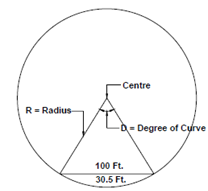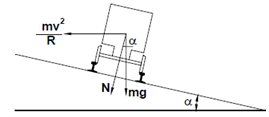Horizontal Curves - Railways
In railway engineering, the horizontal curve is defined by its degree as well as by its radius. The degree is the angle subtended at the centre by a chord of 100 ft (30.5 m).

Figure: Degree of a Curve
D = 360/2π R× 30.5
assuming that the length of chord and arc is the same.
= 1750/R
For Broad Gauge, the maximum degree of curvature permitted is 100 or 175 m radius.
When a train is travelling on a curve, the outer rail has to be raised with respect to the inner rail to counteract the centrifugal force (Figure).

Figure: Force on a Vehicle Moving on a Curved Path
The super-elevation (or cant) is given by the equation:
e = V2/gR
where e = Superelevation,
v = Speed in m/sec,
R = Radius in m, and
g = Acceleration due to gravity.
= V2/127 R
where V = Speed in Km/hr.
The maximum super-elevation provided on a BG track is 165 mm. A horizontal curve requires transitional ends.